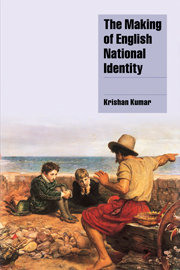Book contents
- Frontmatter
- Contents
- Preface
- 1 English or British? The question of English national identity
- 2 Nations and nationalism: civic, ethnic and imperial
- 3 When was England?
- 4 The first English Empire
- 5 The English nation: parent of nationalism?
- 6 The making of British identity
- 7 The moment of Englishness
- 8 The English and the British today
- Notes
- List of references
- Index
- Cambridge Cultural Social Studies
6 - The making of British identity
Published online by Cambridge University Press: 07 December 2009
- Frontmatter
- Contents
- Preface
- 1 English or British? The question of English national identity
- 2 Nations and nationalism: civic, ethnic and imperial
- 3 When was England?
- 4 The first English Empire
- 5 The English nation: parent of nationalism?
- 6 The making of British identity
- 7 The moment of Englishness
- 8 The English and the British today
- Notes
- List of references
- Index
- Cambridge Cultural Social Studies
Summary
The Isle within itself hath almost none but imaginary bounds of separation, without but one common limit or rather guard of the Ocean sea, making the whole a little world within itself, the nations an uniformity of constitutions both of body and mind, especially in martial processes, a community of language (the principal means of civil society), an unity of religion (the deepest bond of hearty union and the surest knot of lasting peace).
King James the Sixth and First, 1604 (in Rowse 1957: 315)Countries are not laid up in heaven; they are shaped and reshaped here on earth by the strategems of men and the victories of the fortuitous. But once they take root and are bolstered by the habits and mechanics of unity and by a common mythology, they soon acquire an image, if not of immemoriality, at least of almost inevitable and organic development.
R. R. Davies (2000: 54)One nation divided
The seventeenth century has always seemed an unpromising time to look for expressions of English nationalism, which is probably why we do not hear of many claims to find it there. Its principal characteristic, in England as elsewhere, is conflict and division. It is the period of the Thirty Years War, of rebellions and revolutions in practically every major European country. ‘These days are days of shaking’, declared an English preacher in 1643, ‘and this shaking is universal: the Palatinate, Bohemia, Germania, Catalonia, Portugal, Ireland, England’ (in Trevor-Roper 1965: 59).
- Type
- Chapter
- Information
- The Making of English National Identity , pp. 121 - 174Publisher: Cambridge University PressPrint publication year: 2003
- 1
- Cited by



